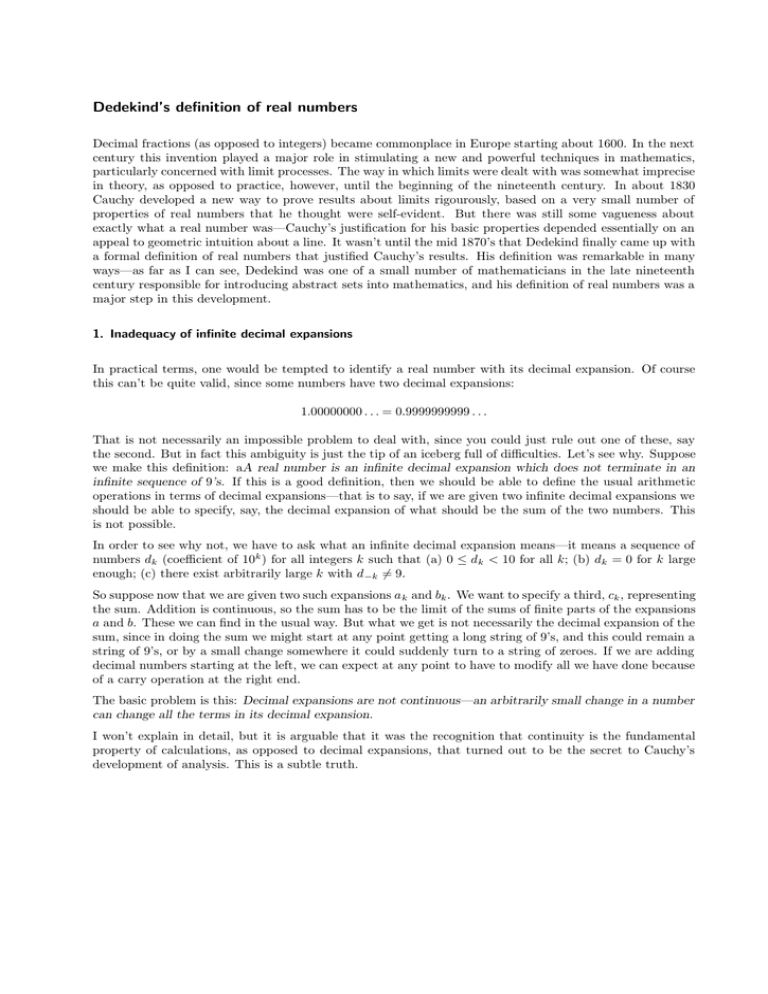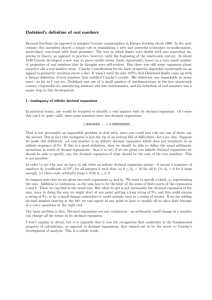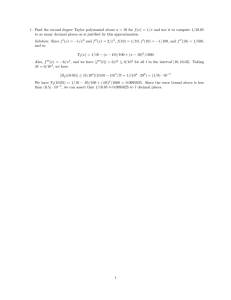Dedekind’s definition of real numbers
advertisement

Dedekind’s definition of real numbers Decimal fractions (as opposed to integers) became commonplace in Europe starting about 1600. In the next century this invention played a major role in stimulating a new and powerful techniques in mathematics, particularly concerned with limit processes. The way in which limits were dealt with was somewhat imprecise in theory, as opposed to practice, however, until the beginning of the nineteenth century. In about 1830 Cauchy developed a new way to prove results about limits rigourously, based on a very small number of properties of real numbers that he thought were self-evident. But there was still some vagueness about exactly what a real number was—Cauchy’s justification for his basic properties depended essentially on an appeal to geometric intuition about a line. It wasn’t until the mid 1870’s that Dedekind finally came up with a formal definition of real numbers that justified Cauchy’s results. His definition was remarkable in many ways—as far as I can see, Dedekind was one of a small number of mathematicians in the late nineteenth century responsible for introducing abstract sets into mathematics, and his definition of real numbers was a major step in this development. 1. Inadequacy of infinite decimal expansions In practical terms, one would be tempted to identify a real number with its decimal expansion. Of course this can’t be quite valid, since some numbers have two decimal expansions: 1.00000000 . . . = 0.9999999999 . . . That is not necessarily an impossible problem to deal with, since you could just rule out one of these, say the second. But in fact this ambiguity is just the tip of an iceberg full of difficulties. Let’s see why. Suppose we make this definition: aA real number is an infinite decimal expansion which does not terminate in an infinite sequence of 9’s. If this is a good definition, then we should be able to define the usual arithmetic operations in terms of decimal expansions—that is to say, if we are given two infinite decimal expansions we should be able to specify, say, the decimal expansion of what should be the sum of the two numbers. This is not possible. In order to see why not, we have to ask what an infinite decimal expansion means—it means a sequence of numbers dk (coefficient of 10k ) for all integers k such that (a) 0 ≤ dk < 10 for all k; (b) dk = 0 for k large enough; (c) there exist arbitrarily large k with d −k 6= 9. So suppose now that we are given two such expansions a k and bk . We want to specify a third, ck , representing the sum. Addition is continuous, so the sum has to be the limit of the sums of finite parts of the expansions a and b. These we can find in the usual way. But what we get is not necessarily the decimal expansion of the sum, since in doing the sum we might start at any point getting a long string of 9’s, and this could remain a string of 9’s, or by a small change somewhere it could suddenly turn to a string of zeroes. If we are adding decimal numbers starting at the left, we can expect at any point to have to modify all we have done because of a carry operation at the right end. The basic problem is this: Decimal expansions are not continuous—an arbitrarily small change in a number can change all the terms in its decimal expansion. I won’t explain in detail, but it is arguable that it was the recognition that continuity is the fundamental property of calculations, as opposed to decimal expansions, that turned out to be the secret to Cauchy’s development of analysis. This is a subtle truth. Dedekind’s definition of real numbers 2 2. Cuts As far as I know, there is no way to base a theory of real numbers on some practical way of representing them. Dedekind’s brilliant idea was to use an impractical one. There are two basic points behind Dedekind’s definition of a real number: (1) the geometric intuition that any real number divides the set of all real numbers into two halves, those smaller and those bigger; (2) and real number can be approximated arbitrarily well by rational numbers. Thus, we can think of a real number not just by its infinite decimal expansion, but by the way in which all rational numbers approximate it. Think about the ideal way in which we would find better and better approximations to a real number x: We pick a rational number r at random, and ask, how can we find a better approximation to x than r? We ask, is r ≤ x or not? If so, then we choose a bigger one, say r + 1, and ask the same question. Sooner or later we’ll come up with a pair r and s with r ≤ x and x ≤ s. (Similarly if r > x originally.) Now we bisect this pair to get t = (r + s)/2, and ask whether t ≤ x or not. If it is, then we replace r by t and if not we replace s by t. Continue on in this way. The crucial point here is that to find a sequence of rational approximations to a real number x, all we have to do is be able to answer this question: • If r is a rational number, is r ≤ x or not? Or in other words, to be able to specify in some sense the set A x of all rational numbers r with r ≤ x, or equivalently the set Bx of all r with r > x. Or both. Dedekind defines a cut to be a partition of the real numbers into two sets, say A and B, with these properties: (c1) Neither A nor B is empty; (c2) Every rational number is in either A or B but not both; (c3) If a lies in A and b in B then a < b. Of course if one of these is given then the other is just its complement, the set of rational numbers that are not in it. So a cut is equally well determined by a single set A such that (a1) There exist rational numbers that do not belong to A; (a2) Whenever r lies in A and s doesn’t, then r < s. Let’s check whether these definitions are quite what we expect by proving a few elementary properties. • Suppose that A determines a cut, let B be its complement. (i) If a0 < a and a lies in A, so does a0 ; if b belongs to B and b < b 0 then b0 also lies in B. Proof. By contradiction. If a 0 does not lie in A then it lies in its complement. But then by assumption a < a0 . Oops. Second assertion similarly. We now want to define a real number to be a cut. There is a technical problem, since if x is a rational number, there are two cuts associated to it—one of r ≤ x and the other of r < x. We choose the first. This leads to: • A real number is defined to be a cut (A, B) with the property that B has no least element. If we are given a cut (A, B) which does not have this property, we get one that does by swapping the least element of B into A. I call this standardization of the cut. So a real number x from now on in these notes is neither more nor less than a standard cut (A, B), determined by a set A with the properties listed above, and in addition such that the complement of A has no least element. Dedekind’s definition of real numbers 3 3. Defining arithmetic operations Let’s see if we can define addition, which we couldn’t do if we defined a real number to be a decimal expansion. Suppose x and y are two real numbers. Define a set A to be the set of all rational numbers r + s with r in Ax and s in Ay . It may happen that the complement B has a least element, in which case we remove it from B and add it to A. To see that the set A determines a cut, we have to check that if b lies in B and a in A then a < b. If not, then b ≤ a. Can’t have b = a, so b < a. We want to derive a contradiction, say by showing now all a0 < a have to lie in A, including b. Now a lies in A, so we can write a = r + s with r in Ax , s in Ay . We also have a0 < a. If we can find r0 < r and s0 < s such that a0 = r0 + s0 then we know r0 lies in Ax and s0 lies in Ay , so that a0 also lies in A. But if we let c = a − a0 , it will be a positive rational number, and a0 = a − c = r + s − c = (r − c/2) + (s − c/2) = r 0 + s0 .




